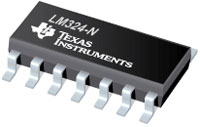Texas Instruments' LMx24N series consists of four independent, high-gain, internally frequency compensated operational amplifiers designed to operate from a single power supply over a wide range of voltages. Operation from split-power supplies is also possible and the low-power supply current drain is independent of the magnitude of the power supply voltage.
Application areas include transducer amplifiers, DC gain blocks and all the conventional op amp circuits which now can be more easily implemented in single power supply systems. For example, the LMx24N series can directly operate off of the standard 5 V power supply voltage which is used in digital systems and easily provides the required interface electronics without requiring the additional ±15 V power supplies.
| Features |
|
Advantages |
- Internally frequency compensated for unity gain
- Large DC voltage gain 100 dB
- Wide bandwidth (unity gain) 1 MHz (temperature compensated)
- Wide power supply range:
- Single supply 3 V to 32 V or dual supplies ±1.5 V to ±16 V
- Very low supply current drain (700 µA) essentially independent of supply voltage
- Low input biasing current 45 nA (temperature compensated)
- Low input offset voltage 2 mV and offset current: 5 nA
- Input common-mode voltage range includes ground
- Differential input voltage range equal to the power supply voltage
- Large output voltage swing 0 V to V+ - 1.5 V
Applications
- Transducer amplifiers
- DC gain blocks
- Conventional op amp circuits
|
|
- Eliminates need for dual supplies
- Four internally compensated op amps in a single package
- Allows direct sensing near GND and VOUT also goes to GND
- Compatible with all forms of logic power drain suitable for battery operation
- In the linear mode, the input common-mode, voltage range includes ground and the output voltage
- Can swing to ground, even though operated from only a single power supply voltage
- Unity gain cross frequency is temperature compensated
- Input bias current is also temperature compensated
|
